|
|
The National Park Timanfaya in Lanzarote
The Parque Nacional de Timanfaya has made the island Lanzarote world famous, as there is hardly another place in earth where one can experience such a big volcanic area so closely as is the National Park. Only the surfacd of the National Park is 51 km² big; the lava field itself covers with approximately 170 km² a quarter of the whole surface of Lanzarote; With this size, it is bigger as none in the world. 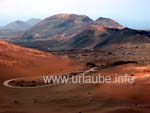
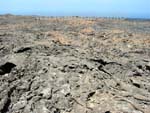
The Area that was declared to a National Park in the year 1974 is named after the former big village Timanfaya, that was overwhelmed during the eruptions of 1730-1736 as so many other villages were. In that time, the earth repeatedely opened in different areas for six years, partly simulataneously in different areas. More than two dozens lava domes were originated in that time and some of them spit so much lava, lapilli and ash that the recently born volcanic vents were immediately burried again. They were the biggest volcanic eruptions of the historical time that in the years 1730-1736 burried a quarter of the surface of Lanzarote with a coat of several metres thickness and destroyed a major part of the fertile ground that was agriculturally used. The lates eruptions took place in the year 1824, but in the Timanfaya region it still seethes under the earth. Only a few centimetres under the earth surface, the temperature is partly exceeding 100°C, in 6 m depth, the thermometre indicates more than 400°C. As terrible and destroyable the catastrophy was in 1730, as fascinating and well worth seeing is the Timanfaya region today. Here, one sees in a very compact place everything what the volcanism can effect to the earth: starting from nice and pointy hornitos there are lava domes up to the scarring Calderas (basins) with a diametre of hundreds of metres. The volcanic mountains glisten, depending on the sun radiation and outer temperature in different colours from depp black to fire red. There are huge lava fields, ash and lapilli desserts and even subterranean lava tunnels. Visiting the National Park TimanfayaThe visit to the Parque Nacional de Timanfaya is an absolute "must" for each visitor of Lanzarote; Even pure seaside vacationers rent a car for at least one day or book a bus tour to visit this spot of the island. There are three interesting possibilities to experience closely this huge volcanic area: 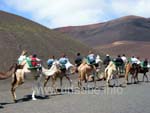
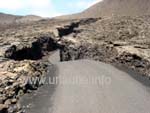
For families with children, of course the ride on the dromedaries is the highlight of the whole holiday. There are more than 200 camels, that carry every day thousands of tourists through the national park. The dromedaries wear a muzzle and are guided by a leader. This spectacle costs approximately 5 € per person. Of course,one is decently shaked during such a ride. Since a long time, the dromedaries were agriculturally used in Lanzarote; in former years, they plowed the fields and transported goods. At least as spectacular is the bus tour through the volcano route Ruta de los Volcanos; At the Islote de Hilario the buses depart any half an hour to a 45 minutes round tour through the National Park. This road cannot be driven with the own car, it would be too dangerous, as the road is not secured and it partly goes stepply down the hill at the left and at the right side. For the bus drivers, the job seems to be an amusement, as they pretty push the accelerator on these narow mountain roads. 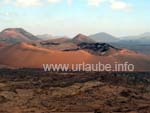
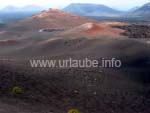
The bus tour is included in the entrance fee to the National Park (6,50 €). By the way, it is highly forbidden in the National Park to do a step aside the roads and parking places, as each footstep on a lava sotne that is vegetated with a lichen destroys a piece that was created by the nature more than 200 years ago. The bus tour on the Ruta de los Volcanos is so spectacular that is hard to describe with words. One drives deeply through the lava fields, can look into the craters of the volcanos and can even drive through a vent. The views to the volcanos, lava- and ash fields are breathtaking if one considers two tips: 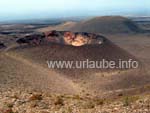
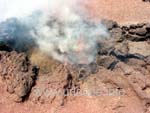
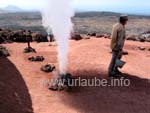
In connection to the bus tour, it is demonstrated on the Islote de Hilario how it still seethes under the earth: if some brushwood is put into a little buttow, it immediately inflames and burns up. The lapilli stones that lie on the earth are so hot that they can hardly be taken with the bare hand. And then, there is the suprise effect with the water fountain, where a bucket of water is poured into a tube of a depth of approximately 10 m and it eveporates in seconds... In Mancha Blanca there is a visitor centre where one can learn a lot of volcanism, meteorology, the flora and fauna of the island and the history of Lanzarote. The film of nearly one hour that is recomended by lots of people is, to the contrary, extremely boring and more an advertising program for Lanzarote as an informative movie. Additionally, the film is in spanish language; the headphones with german translation cost 2 €; then one hears two languages simultaneously. 
Copyright: Patrick Wagner, www.tourist-guide.biz |
||
 Those who have a rented car should better drive in the afternoon to the Islote de Hilario, as in the mornings all tourist buses drive to the National Park Timanfaya so that the waiting times can get very extensive.
Those who have a rented car should better drive in the afternoon to the Islote de Hilario, as in the mornings all tourist buses drive to the National Park Timanfaya so that the waiting times can get very extensive.